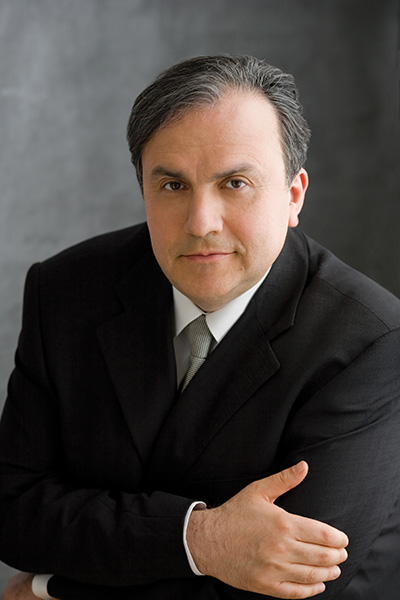
Yefim Bronfman, one of the towering pianists of our time, performed a recital on Wednesday evening at Walt Disney Concert Hall featuring works by Schubert, Schumann, Salonen, Chopin and Prokofiev.
Bronfman began the program with the Piano Sonata in A minor, D 784, Op. 143 by Schubert. This sonata is much more intimate and, indeed, shorter than the A minor Sonata, D. 845, Op. 42, which he composed two years later, and which is much more well known. The former was not published in his lifetime; the latter was.
Bronfman instantly hushed the audience with the sonata’s pianissimo beginning. Throughout, Bronfman displayed an exquisite control vacillating between pianissimo and fortissimo and, especially in the third movement, Allegro vivace, which, in a way, makes one think of the finale of Chopin’s Sonata, No. 2, Op. 25, which was published 17 years later.
Bronfman concluded the first half with the Faschingsschwank aus Wien (Carnival Scenes from Vienna) Op. 26 and, as with the Schubert, a work that is not performed as often as another of Schumann’s compositions — the Carnival, Op. 9, composed five years before the Faschingsschwank aus Wien. Just as Bronfman conveyed the classical — almost romantic — nature of the Schubert, he gave the audience a full-fledged romantic interpretation of the Schumann.
Bronfman chose two works by masters of the piano both of which are lesser known than others of their piano works. Why? Perhaps Bronfman wanted to take the road less traveled to allow him to perform something different than what might be expected. Or perhaps Bronfman just loves these two works. For those in the audience not as familiar with these two works, it was a treat to hear them — maybe even for the first time — performed by a modern-day master of the piano.
The second half of the recital was kind of a smorgasbord of offerings, beginning with Sisar, a short prelude composed by Esa-Pekka Salonen for Bronfman. As Salonen wrote in his own program notes, “the character of Sisar is capricious and dreamlike with sudden bursts of kinetic energy interlaced with more static, calmer music.” With the score in front of him and turning his own pages, Bronfman showed why he was a worthy dedicatee. He perfectly balanced the two competing forces — the dreamlike and the kinetic — in the music.
Next up was the Chopin Nocturne No. 8 in D-flat major, Op. 27, No. 2. This most famous and well-known of all the Chopin nocturnes was the calm before the (Prokofiev) storm, and Bronfman played it with the delicacy it deserves.
Bronfman finished out the recital with the Piano Sonata No. 7 in B-flat major, Op. 83 by Prokofiev. It was in the sonata that Bronfman showed his power at the keyboard. His physique, not unlike that of Russian pianist Grigory Sokolov, is tailor-made for works like the Prokofiev sonata.
The B-flat major sonata is like a compact explosive device. In fact, the sonata is one of Prokofiev’s so-called “War Sonatas,” composed in 1942 at the height of WWII. What Prokofiev packs into about 19 minutes is an astonishing array of musical devices. The first movement, Allegro inquieto (worried, anxious), begins quietly and restlessly until it erupts in measure 23 with its signature four-note chords in the lower registers, sounding like explosions. The movement ends as it began: quietly, but still restlessly. The second movement, Andante caloroso (warmly), begins with a heartwarming melody followed by a longer middle section, which reverts back to the disquiet of the first movement before returning to the melodic beginning. The third movement, aptly titled Precipato (fallen, crashed, collapsed to the ground), is in toccata form (meaning fast moving with virtuosic passages). The movement — the shortest of the three and the only one that is actually in the key of B flat — starts melodically enough, but then the signature B flat-C sharp-B flat bass figure shows up, which disappears and then reappears toward the end. The music gradually becomes more and more frenetic before finally crashing into four B flat octaves. In the hands of Bronfman, the movement lived up to its meaning. He accentuated the propulsive nature of the last movement so much so that the audience felt like the playing was literally moving them.
Overall, Bronfman gave a mesmerizing, commanding performance of the Prokofiev that brought the adoring Bronfmanians to their feet demanding an encore.
Bronfman gave the audience two encores: the Arabesque in C Major, Op. 18 by Schumann — the calm after the (Prokofiev) storm — which he played gently and restfully, followed by another stormy piece: the Prelude in G Minor, Op. 23, No. 5 by Rachmaninoff, which he delivered with passion.
In his recital, Bronfman showed why he is one of the most celebrated pianists of our time.
—Henry Schlinger, Culture Spot LA
For information about upcoming concerts, visit www.laphil.com.
Photo credit: Yefim Bronfman / photo courtesy of the artist’s website





